5 Best Employee Handbook Examples for Remote Companies

For companies hiring remotely, having a clear and strong employee handbook is an absolutely must.
Yet, too many companies exploring remote work neglect to update their current guidelines or think about how it might need to change to support this flexible way of working.
And yes, it can take time to get the company leaders together to piece it all together. But it’s what will ensure your company functions well when employees are working around the world.
Plus, having a strong handbook will make it easier to attract new top talent, help onboard new employees faster, and keep the entire organization better aligned.
So if your company is just exploring hiring remotely, you’ve become remote-first but need some guidance, or want to refresh your current remote handbook – this article is for you. Below, you’ll find the best employee handbook examples for remote companies.
Employee Handbook Examples for Remote Companies
Some of the best employee handbook examples for remote companies are GitLab, 37Signals, Remote, ConvertKit, and PostHog. Each provides well thought out details, employee expectations, and makes it accessible for employees and job seekers alike.
But to fully grasp how good these employee handbooks are, let’s take a bit of a closer look at each.
1. GitLab
GitLab is one of the leaders in the remote-first movement and has continued to be successful since 2014. The company’s DevSecOps platform enables your entire organization to collaborate around your code.
And since they have been remote-first and often have roles open to anywhere in the world, the company needed a strong remote employee handbook. And boy, do they have an in-depth handbook.
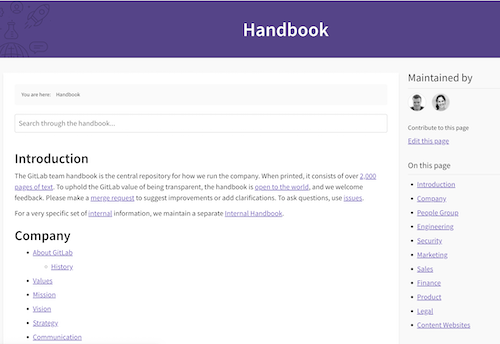
t’s quite extensive and covers everything from their beliefs as a company, individual departments, legal, and more. But what also makes this public handbook unique is that they allow employees or anyone else to submit edits to improve the guide.
2. 37Signals (Basecamp)
37Signals (or as it is formerly known as Basecamp) is one of the pioneers in being a remote-first org. I’ve also featured 37Signals key leaders Jason Fried and David Heinemeier Hansson on our top remote experts list too.
Their approach was a bit different as for the first ten years of the business, they chose to not have a handbook. As they started out small, they wanted those team members to figure it out on their own.
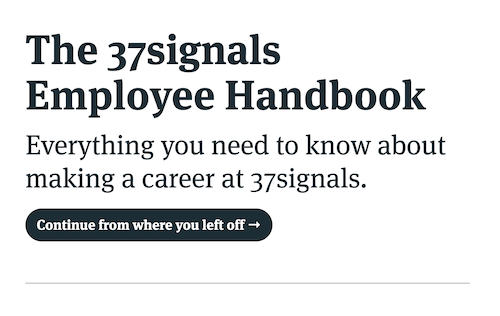
But as they stated in their remote handbook, it became more difficult once they grew past 50 employees. By creating this public guide, they made it easy to state what they stand for, the culture they wanted to build, vocabulary used, product history, rituals, and much more.
Similar to GitLab, you can also suggest improvements for their handbook. And this is one handbook I highly suggest you check out if you need inspiration at your company.
3. Remote
Remote became one of the largest software platforms that helps companies hire anyone remotely around the world. It will handle things like taxes in those countries, payroll, expense management, and much more.
Beyond helping teams hire and manage remotely, the company itself is also remote-first. And with that, the leaders also built a public employee handbook.
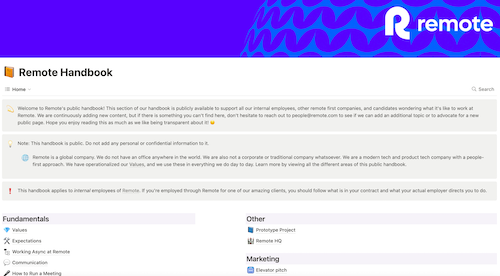
This particular handbook was built on Notion, where GitLab and 37Signals built custom pages on their website. Using Notion, doesn’t mean Remote did not put a ton of thought and work into their handbook though.
In the Remote employee handbook, you’ll find well-organized details around the fundamentals (communication, running meetings, time zones), people (awards, benefits, career paths), marketing, product, legal, and more.
4. ConvertKit
If you have been in the tech world, then you’ve probably heard of ConvertKit. Not only for a savvy business and compounding growth being bootstrapped, but for their remote-first approach to hiring too.
I won’t get into the details of this amazing business and product, but a quick Google search will yield you plenty of results if you are curious.
That said, I’m a fan of their handbook for remote employees. The company has always had a “work in public” mentality, so no surprise their handbook is also public and transparent.
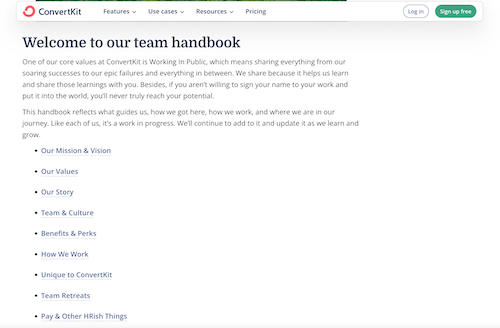
ConvertKit covers all the major areas you’d expect like mission, values, company story, culture, benefits, how they work, team retreats, etc. And each section does a deep dive calling out all the major information one might inquire about.
Checkout ConvertKit’s Handbook
5. PostHog
PostHog provides various tools for engineers and product leaders in an open source format. Think product analytics, session replay, feature flags, A/B testing, data warehouse, CDP, surveys.
While this software company doesn’t often land in lists around remote-first organizations, they should! The business has been successful and has found top talent by hiring remotely around the world.
And since the team is remote, the PostHog team built an amazing employee handbook. It’s designed well and makes it very easy to learn if this is a company you’d want to work at.
The About page is well throughout and the company top menu dropdown has various options for you to learn about the business. Yet, it’s the handbook you’ll want to jump into.
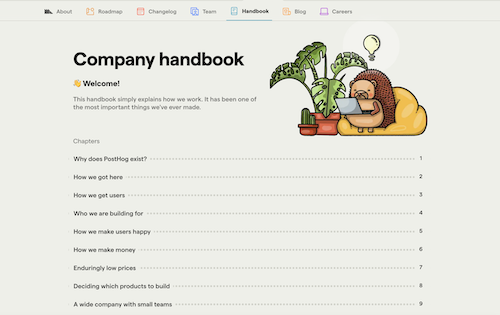
The employee handbook is organized like a book in chapters, allowing you to jump to the section you want to learn more about. It covers various areas like why PostHog exists, how they got where they are now, who they’re building for, how they’re building a remote team, values, and more.
Creating A Good Handbook for Remote Workers
Often companies that are new to remote work or their leaders have never led a remote organization can struggle with the cultural change.
And that can be a reason the company fails at remote work and retreats back to hybrid or a full return to the office.
I've seen it before, where the founders or company leaders do not really think about how working remotely has very different internal needs. But it does!
What I’ve seen that is common with these companies is they adapt the same exact policies, handbooks, and management style like they are in the office. But this almost always leads to failure.
Certainly there is some overlap and common practices, but there are necessary changes and adoption of different policies to make it work well.
Beyond the great examples of remote work handbooks above, here are some things to keep in mind as you build (or rebuild) the current one.
- Mission Statement – Remote or not, your employee handbook should state why you started the company and how you’re going to accomplish your mission.
- Culture Guidelines – Another section you’ll find on any good employee handbook, even if it’s not a remote company. But your cultural section is an outline of the beliefs your company will practice internally and externally. What do you stand for? What are your virtues?
- Expectations – Transparency and trust are critical for remote work and teams to operate efficiently. So ensure your remote handbook includes pay, team structures, tools, how to communicate as a team, setting goals or OKRs, etc.
- Legal Policies – The legal stuff is not very glamorous, but necessary to include within your handbook. This should exist to clearly inform employees on their rights and other policies. Think medical leave, dress codes, vacations, etc.
- Company Personality – What personality do you want your company and remote team to have? Your handbook can be the perfect place to let this shine through, especially in the writing. So while you are thinking about many important things to include, do not forget how you want employees to feel about the brand and culture.
- Handbook Presentation – How will your company present and document the handbook for remote workers? There are many options like Notion, customer landing pages, Google doc, interactive website pages, PDF, etc.
The remote handbook examples above have different styles, but also have it clearly visible on their public website. Think about how you want to design, present it, and ultimately – how accessible it is to the outside world.
Final Thoughts
As you’ve seen in some of the employee handbook examples above, there is no exact way to create or style it.
While there is common info across the examples and areas you’ll definitely want to cover, it’s ultimately your company’s decision on how to best present it.
But the common thing you may have noticed about these handbooks is that they're very detailed, clear, transparent, and the organizations are giving trust to the employee.
Set the expectations early in your custom guidelines and start building an amazing remote company. You’ll quickly start to reap the benefits as a business and find amazing talent clamoring to work at your company.











